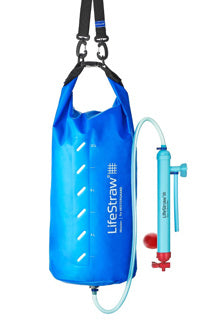LIFESTRAW
LifeStraw Mission - 5L
LifeStraw Mission - 5L
Couldn't load pickup availability
LifeStraw Mission - 5LHigh volume gravity water filter and purifier
Products that use membrane ultrafiltration technology are classed as purifiers because they remove viruses.
Protects against viruses, bacteria, parasites, dirt, sand, and cloudinessMeets NSF/ANSI P231 drinking water standards for the reduction of viruses, bacteria, and parasites
Independently lab tested, durable and BPA FreeFood grade materials (US FDA 21 CFR standards)Bag is made of durable, TPU laminated nylon Every fill avoids single use plastic bottled water!Replacement filters and accessories availableSpecifications:Weight: 0.53kg 5 L Hose Length: 80cm5 L Bag Size: 40.1 x 17cmFilter Size: 32 cmMax Flow Rate: 12 L/hrIncludes: 5-liter gravity bag with quick-connect hose, water purification cartridge and built-in backwashing systemFilter Specification:
The LifeStraw Membrane Ultrafilter Removes:99.999999% of bacteria 99.999% of parasites 99.999% of viruses99.999% of microplastics, dirt, sand, and cloudiness Pore size: 0.02 micronLasts up to 4,755 gal |18,000 L Membrane Ultrafilter v Membrane Microfilter:
The difference between membrane microfilters and membrane ultrafilters is the pore size. LifeStraw's membrane ultrafilter pores are 0.02 micron —10 times smaller than the pores of the membrane microfilter.
Both technologies work via the same mechanism, but ultrafilters also block viruses due to the smaller pore size. When dirty water enters the ultrafilter, the microscopic pores block viruses, bacteria, parasites, microplastics, dirt, and other turbidity forms. Clean water passes through the pores in the membranes making the water microbiologically safe to drink. Because of the smaller pore size, ultrafilters often have a slower flow rate or require more pressure to purify water than microfilters.?
LifeStraw Membrane Ultrafilters are capable of removing 99.999% (log 5) of viruses (including Rotavirus), 99.999999% (log 8) of bacteria (including E. coli and Salmonella), 99.999% (log 5) of parasites (Giardia and Cryptosporidium), and 99.999% (log 5) of microplastics. ses, bacteria, and parasites


